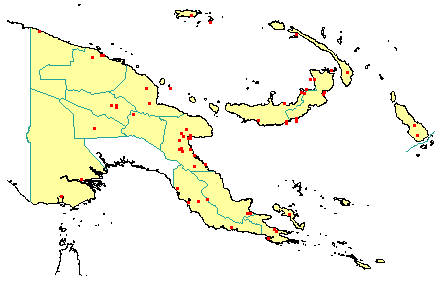
in PNGplants database
PNGTreesKey – Aglaia sapindina (F.Muell.) Harms |
Barry Conn (NSW) & Kipiro Damas (LAE).
Guide to trees of Papua New Guinea
Copyright held by the authors, National Herbarium of New South Wales, and Papua New Guinea National Herbarium
in Engler & Prantl, Die Natürlichen Pflanzenfamilien Vol. iii (IV): 298
Other Literature: C.M. Pannell, Flora Malesiana, Series 1 283-285 (1995)
Family: Meliaceae
Dicotyledon
Timber Group: Occasional timber species Tradename: Aglaia
Field Characters: Large canopy tree (up to 35 m high) or Small sub-canopy tree (10-20 m high, rarely as short as 4 m); Bole cylindrical (14-45 cm diam., occasionally up to 120 cm); straight (often very short, usually at least 2 m long); buttresses buttresses present or buttresses absent; spines spines absent; aerial roots aerial roots absent; stilt roots stilt roots absent; Bark grey or reddish brown, rough or smooth, scaly or flaky (small flakes) or slightly pustular, lenticels elongated vertically or lenticels rounded/swelling (small reddish brown or black lenticels); Subrhytidome (under-bark) mottled, white, red, or yellow (pale straw-coloured); less than 25 mm thick, 5.0-10.0; bark blaze consisting of one layer; faintly to non-aromatic; unpleasant; outer blaze white, pale pink, or pale brown, markings absent, fibrous; inner blaze white, pale pink, or pale brown, markings absent, fibrous; bark exudate (sap) present, white/milky, not readily flowing (spotty), colour not changing on exposure to air, sticky; terminal buds not enclosed by leaves.
Indumentum: Complex hairs present, disk-shaped (peltate) (on branchlets, leaves, flowers and fruits); stinging hairs absent; mature twig indumentum (hairs) absent.
Leaves: Leaves spaced along branches, spiral (leaves occurring singly at a node and arranged spirally up the branchlet), compound (a leaf made up from two or more leaflets); petiole present, not winged, attached to base of leaf blade, not swollen; leaves pinnate (unbranched with more than three leaflets); petiolule not swollen; rachis present, absent, absent; leaves with a terminal leaflet (the number of leaflets odd - imparipinnate), equally broad throughout much of length, (7.0-) 10.0-30.0 (-45.0) cm, (5.0-) 7.0-13.0 (-21.0) cm, leaflets opposite, symmetric, terminal developing leaflet buds straight; venation pinnate, secondary veins open, prominent, intramarginal veins absent; leaves lower surface pale blue-green or pale green, upper surface dark green (glossy), indumentum (hairs) present, indumentum (hairs) dense or sparse (peltate scales); absent; domatia absent; stipules absent.
Flowers: Inflorescence axillary or on the trunk or branches (by misinterpretation below dehiscent leaves), flowers on a branched axis, cones absent; flowers bisexual, stalked, flowers with many planes of symmetry, 5.0 (c.) mm long, diameter small (up to10 mm diam.) (5 mm diam.); perianth present, with distinct sepals and petals whorls, inner perianth pale yellow; 5, free or some or partly joined; stamens 5, present, free of each other, free of the perianth; ovary superior, carpels joined (when more than one), locules 2; styles absent (with broad stigma sessile).
Fruits: Infrutescence arranged on branched axis, fruit 10.0-20.0 mm long, 10.0-20.0 mm diam., green or brown, not spiny (moderately to densely covered with peltate scales), non-fleshy or fleshy (leathery), simple, slightly dehiscent, capsule; seeds 1-(0 or 1 seed per locule)-2, much more than 10 mm long (12-15 mm long), not winged, narrow (longer than wide), seed 1-10 mm diam. (10-15 mm diam.).
Distribution: West Sepik, East Sepik, Madang, Morobe, Western Highlands, Eastern Highlands, Southern Highlands, Western, Central, Northern, Milne Bay, Papuan Islands, New Britain, New Ireland, Manus & Bougainville.
 | Botanical records in PNGplants database |